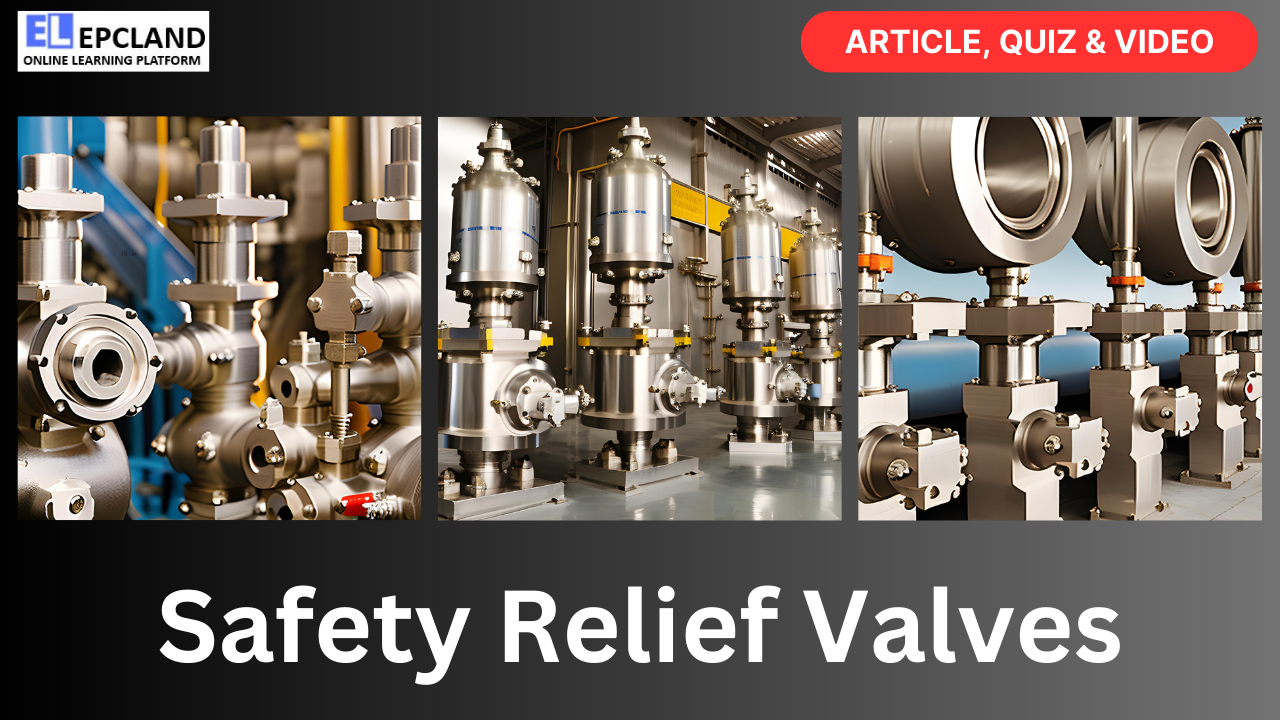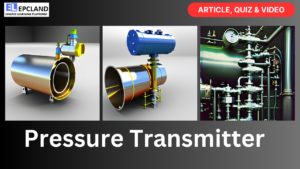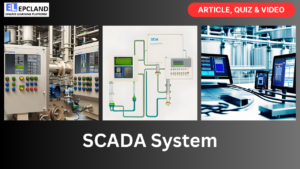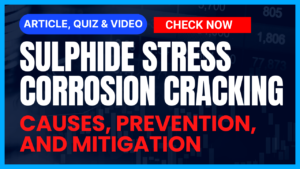The Oil and Gas Industry is known for its complex and potentially hazardous operations. Safety is of paramount importance, and various safety measures and equipment are employed to mitigate risks. One such critical component is the Safety Relief Valve (SRV). In this article, we’ll delve into the importance, functioning, types, maintenance, and regulations governing Safety Relief Valves in oil and gas industry projects.
Table of Contents
Do not miss the detailed course 7 Modules of Piping Codes & Standards
Enrollment link
Introduction to Safety Relief Valves
Importance of Safety Relief Valves
Safety Relief Valves, often abbreviated as SRVs or SRVs, serve as the last line of defense against overpressure in process equipment and piping systems within the oil and gas industry. These valves play a crucial role in preventing catastrophic failures, protecting personnel, equipment, and the environment.
Function of Safety Relief Valves
The primary function of a Safety Relief Valve is to automatically and immediately relieve excess pressure from a system to prevent overpressure scenarios. Overpressure can result from various factors, including equipment malfunctions, thermal expansion, or external fire exposure. When the pressure exceeds a predetermined set point, the SRV opens, allowing fluid or gas to escape, thus reducing the pressure in the system.
Types of Safety Relief Valves
Safety Relief Valves come in various types to suit the specific needs of different processes and applications in the oil and gas industry. Here are some common types:
1. Spring-Loaded Safety Relief Valves
- These valves use a spring-loaded mechanism to maintain system pressure within safe limits.
- When the pressure exceeds the set point, the spring compresses, allowing the valve to open and relieve excess pressure.
2. Pilot-Operated Safety Relief Valves
- Pilot-operated SRVs are used in high-pressure systems.
- They consist of a main valve and a pilot valve.
- The pilot valve controls the opening and closing of the main valve in response to pressure changes.
3. Balanced Safety Relief Valves
- Balanced SRVs are designed to minimize the effects of backpressure on the valve’s operation.
- They are suitable for applications with fluctuating backpressure conditions.
4. Conventional (Direct-Acting) Safety Relief Valves
- Conventional SRVs are simple and reliable.
- They open directly in response to the pressure exceeding the set point.
5. Rupture Discs with Safety Relief Valves
- Rupture discs are often used in conjunction with SRVs.
- The rupture disc bursts at a predetermined pressure, and the SRV opens to provide ongoing pressure relief.
Design and Sizing of Safety Relief Valves
Set Pressure
The set pressure of an SRV is a crucial parameter. It is the pressure at which the valve begins to open and relieve excess pressure. The set pressure should be carefully calculated to ensure that it is below the maximum allowable working pressure (MAWP) of the equipment or system.
Overpressure Margin
A safety margin, typically around 10% above the MAWP, is usually incorporated into the set pressure to account for fluctuations and ensure the valve opens when required.
Sizing Criteria
Sizing an SRV involves determining the required capacity to safely relieve excess pressure. Factors such as fluid properties, system volume, and operating conditions influence the sizing process. Engineers use industry-standard codes and guidelines to ensure correct sizing.
Maintenance and Testing
Regular Inspection
Safety Relief Valves must undergo routine inspections to ensure they are in proper working condition. Visual inspections, as well as functional tests, are essential to detect any signs of wear, corrosion, or damage.
Testing Frequency
The frequency of testing varies depending on the criticality of the application and local regulations. However, many industry standards recommend testing at least once a year.
Bench Testing
Bench testing involves removing the valve from the system and subjecting it to controlled conditions to verify its performance. This testing checks factors such as the set pressure and the valve’s ability to open and close correctly.
In-Service Testing
In-service testing involves testing the valve while it remains installed in the system. This type of testing ensures that the SRV functions as expected under actual operating conditions.
Do not miss the detailed course 7 Modules of Piping Codes & Standards
Enrollment link
Advantages and Disadvantages of Safety Relief Valves
| Advantages | Disadvantages |
|---|---|
| 1. Critical Safety Component: SRVs are a last line of defense against overpressure scenarios, making them crucial for preventing catastrophic failures. | 1. Maintenance Requirements: SRVs require regular inspection and testing, which can lead to downtime during testing and maintenance periods. |
| 2. Immediate Response: SRVs respond rapidly to overpressure situations, reducing the risk of equipment damage and potential disasters. | 2. Sizing Challenges: Correctly sizing SRVs can be complex, requiring a thorough understanding of system parameters and fluid properties. |
| 3. Protection Against Fluctuations: They provide protection against pressure fluctuations caused by various factors, including equipment malfunctions and external forces. | 3. Limited Reliability: SRVs, like all mechanical devices, may experience occasional failures or malfunctions, necessitating redundancy and backup systems. |
| 4. Regulatory Compliance: Compliance with industry standards and regulations ensures that SRVs meet stringent safety requirements. | 4. Initial Investment: Installing SRVs can be costly, particularly in large-scale operations with multiple pressure relief points. |
| 5. Versatility: Different types of SRVs are available to suit various applications and pressure relief needs. | 5. Noise and Environmental Impact: When SRVs activate, they can generate noise and release potentially harmful substances into the atmosphere. |
Regulatory Standards
The oil and gas industry is highly regulated, and Safety Relief Valves are subject to stringent standards and codes to ensure their reliability and effectiveness. Some of the key regulatory standards include:
1. ASME Boiler and Pressure Vessel Code
- The ASME Boiler and Pressure Vessel Code sets the standard for the design, manufacture, and testing of pressure relief devices, including Safety Relief Valves.
2. API Standards
- The American Petroleum Institute (API) provides a range of standards related to pressure relief valves, ensuring their proper selection, installation, and maintenance in the industry.
3. ISA Standards
- The International Society of Automation (ISA) offers standards and guidelines related to instrumentation and control systems, including safety relief valves.
4. OSHA Regulations
- The Occupational Safety and Health Administration (OSHA) in the United States enforces regulations related to workplace safety, including the use of safety relief valves.
Case Studies: Safety Relief Valve Success Stories
Case Study 1: Offshore Platform Protection
In the harsh environment of offshore oil platforms, safety is paramount. Safety Relief Valves are strategically installed throughout the platform’s piping and equipment to safeguard against overpressure scenarios. In one incident, a sudden surge in well pressure threatened to rupture a critical pipeline. The Safety Relief Valves activated, diverting the excess pressure and preventing a potential disaster.
Case Study 2: Refinery Incident Averted
A large oil refinery relies on a complex network of equipment and pipelines. During routine maintenance, an oversight led to a temporary blockage in a key pipeline. As pressure built up, the Safety Relief Valves opened, safely releasing excess pressure. This prevented a catastrophic rupture of the pipeline and avoided costly downtime.
Conclusion
Safety Relief Valves are unsung heroes in the oil and gas industry, ensuring that operations remain safe and prevent potential disasters. Their proper selection, sizing, installation, and maintenance are critical to their effectiveness. Moreover, adherence to regulatory standards is essential to compliance and safety.
As the industry continues to evolve and face new challenges, Safety Relief Valves will remain an integral part of safeguarding personnel, equipment, and the environment. Their reliability and ability to respond swiftly to overpressure scenarios make them indispensable in oil and gas industry projects.
In summary, Safety Relief Valves are a testament to the industry’s commitment to safety, serving as a crucial element in the intricate web of safety measures that protect the oil and gas industry’s workforce, assets, and the environment.
FAQs
- What is the primary role of Safety Relief Valves in the oil and gas industry?Safety Relief Valves (SRVs) are crucial components in the industry, primarily tasked with preventing catastrophic failures by relieving excess pressure in process equipment and piping systems. Their main role is to protect personnel, equipment, and the environment from overpressure scenarios.
- What are the key types of Safety Relief Valves used in the oil and gas industry, and how do they differ?Safety Relief Valves come in various types, including spring-loaded, pilot-operated, balanced, conventional (direct-acting), and those combined with rupture discs. These types differ in their mechanisms and applications. For example, pilot-operated SRVs are used in high-pressure systems, while balanced SRVs are suitable for applications with fluctuating backpressure conditions.
- How are Safety Relief Valves designed and sized for specific applications in the oil and gas industry?Designing and sizing SRVs involves factors such as determining the set pressure (opening pressure), accounting for an overpressure margin, and considering various sizing criteria like fluid properties, system volume, and operating conditions. Engineers follow industry-standard codes and guidelines to ensure correct sizing.
- What is the importance of regular maintenance and testing of Safety Relief Valves?Regular inspection and testing of SRVs are essential to ensure they are in proper working condition. These maintenance practices help detect wear, corrosion, or damage and ensure that the valves respond swiftly to overpressure scenarios. Bench testing and in-service testing are common methods used for maintenance.
- What are the advantages and disadvantages of Safety Relief Valves in the oil and gas industry?Safety Relief Valves offer advantages such as critical safety protection, immediate response to overpressure, protection against fluctuations, regulatory compliance, and versatility. However, they also have disadvantages, including maintenance requirements, sizing challenges, limited reliability, initial investment costs, and potential noise and environmental impacts.
Do not miss the detailed course 7 Modules of Piping Codes & Standards
Enrollment link
Recommended courses (Published on EPCLand)
- Basics of Piping Engineering
- Piping Layout Engineering
- Piping Material Engineering
- Piping Stress Analysis
- Complete Course on Piping Engineering
- Material Requisitions
- Piping Material Specifications
- Valve Material Specifications
Don’t miss the published articles on following:
| Data Analysis and Technology with Link | Data Analysis and Technology with Link |
| Data Analytics | Industrial Control Networks |
| Machine Learning | The Power of Acoustic Sensors |
Related Video
Attempt Quiz
Question 1:
What is the primary purpose of a safety relief valve in oil & gas projects?
Explanation: The primary purpose of a safety relief valve in oil & gas projects is to prevent overpressure and protect equipment by releasing excess pressure when necessary.
Question 2:
What is the typical set pressure for a safety relief valve in an oil & gas facility?
Explanation: The set pressure for a safety relief valve in an oil & gas facility can vary depending on the specific application and requirements.
Question 3:
What is the key function of the pilot valve in a safety relief valve?
Explanation: The key function of the pilot valve in a safety relief valve is to control the opening and closing of the main valve based on pressure conditions.
Question 4:
What is the typical construction material for safety relief valves in corrosive environments?
Explanation: Stainless steel is a typical construction material for safety relief valves used in corrosive environments due to its corrosion resistance.
Question 5:
What is the purpose of periodic testing and maintenance of safety relief valves?
Explanation: The purpose of periodic testing and maintenance of safety relief valves is to ensure their proper functioning and reliability, enhancing safety in oil & gas projects.



